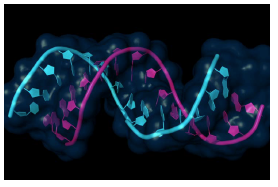Harnessing the Body’s Own Pathways to Silence Genes
 Douglas Fambrough, Ph.D., President and CEO of Dicerna Pharmaceuticals, talks about his company’s research to develop RNAi therapeutics, a newer approach to drug discovery and development.
Douglas Fambrough, Ph.D., President and CEO of Dicerna Pharmaceuticals, talks about his company’s research to develop RNAi therapeutics, a newer approach to drug discovery and development.
About 20,000 genes in the human body are deployed in various ways in different tissues. When inappropriately expressed, these genes can contribute to disease. Genes have their own regulation process, called RNA interference. This is a natural mechanism in the body that is used to shut down inappropriately activated genes.
Biopharma companies are developing ways to capitalize on this natural mechanism, directing RNAi to silence specific genes. One such company is Dicerna Pharmaceuticals.
Dicerna has a proprietary RNAi technology that enables the development of oligonucleotide drugs, treated as small molecules by the FDA with a high degree of selectivity and specificity. The company’s process aims to trigger the destruction of messenger RNAs (mRNAs) of disease-driving genes. Dicerna’s next-generation therapies are processed by the Dicer enzyme, which is the natural initiation point for RNAi within the human cell. As a result, the company’s molecules are referred to as Dicer substrate short-interfering RNAs, or DsiRNAs.
The company’s platform, GalXC, is a technology platform invented by Dicerna. GalXC molecules resemble DsiRNA molecules but have an extended region at one end of the molecule otherwise known as DsiRNA-EX molecules. Generally, this extension is on the part of the molecule cleaved-off by Dicer, and with a GalXC molecule this region is engineered to provide additional functionality to the GalXC molecules.
Dicerna is developing therapies for rare, inherited diseases involving the liver and for other therapeutic areas in which the liver plays a key role.
“What we can do is provide this very specific silencing drug to turn off an individual gene to cells in the liver," says Douglas Fambrough, Ph.D., president and CEO of Dicerna Pharmaceuticals.
The company’s technology only targets the genes in the liver, but Dr. Fambrough points out there are a lot of disease states that involve inappropriately activated genes in the liver.
 While all companies in the RNAi space share a fundamental similarity of trying to capitalize on the RNA interference process, Dicerna’s intellectual approach is able to optimize the RNAi trigger molecules.
While all companies in the RNAi space share a fundamental similarity of trying to capitalize on the RNA interference process, Dicerna’s intellectual approach is able to optimize the RNAi trigger molecules.
“Our drug is a trigger molecule for RNAi," Dr. Fambrough says. “Ours is slightly longer and incorporates a stabilizing motif called the tetraloop that makes these molecules both more stable and easier to work with from both a manufacturing and a chemical modification point of view."
Dicerna’s most advanced program is DCR-PHXC, and it is a potential treatment for the disease primary hyperoxaluria type 1 (PH1). The therapy is a small molecule, a fully synthetic molecule made in a chemical synthesizer.
“This is an ultra-orphan, extremely serious disease," Dr. Fambrough says. “Patients have too much oxalate in the urine. This is a genetic disease, often discovered in childhood, where patients have an inborn error of metabolism and, due to the absence of a specific enzyme, the liver of these patients overproduces a chemical called oxalate. In this situation, the oxalate is excreted through urine and can lead to kidney stones and progressive kidney disease that can lead to end-stage renal disease."
Patients reach end-stage renal disease in their 20s and often require a dual kidney-liver transplant. Dr. Fambrough says the five-year survival rate of those with dual transplants is 64%.
DCR-PHXC can block the production of oxalate, and has the potential to be a functional cure for the disease. Dr. Fambrough says mice with PH1 that have been treated with DCR-PHXC have had oxalate levels decrease, and have metabolic oxalate that is the normal range.
The company plans to begin Phase I trials early in 2018, recruiting patients initially from the company’s observational trial of patients with PH1. These patients are at multiple centers in the European Union, including Amsterdam; the Netherlands; Manchester, England; Bonn, Germany; and Bordeaux, France.
The Phase I trial will be an ascending dose trial where patients get a single dose at a low-level starting in the first cohort and then progressively increasing the dose as the safety is demonstrated.
“We would expect after a small number of cohorts to be at a therapeutically effective dose and we would expect with a single administration of our drug that we can silence the gene responsible for the oxalate production and cause meaningful change on oxalate production even in that single dose," Dr. Fambrough says.
In addition to DCR-PHXC, Dicerna announced two GalXC research programs in 2016: one is focused on cardiovascular disease targeting PCSK9, and the other is an undisclosed rare disease program. The company expects to launch three additional programs annually, with the intent to advance five programs into the clinic by 2019.
PCSK9 is a validated target for hypercholesterolemia. Dicerna’s GalXC RNAi platform has the potential to produce a PCSK9-targeted therapy with more attractive commercial properties than existing monoclonal antibodies, based on comparatively smaller subcutaneous injection volumes and less frequent dosing.
Dicerna is also researching use of the technology in chronic hepatitis B virus. The company has begun preclinical development in this area, and company executives believe they can develop an experimental HBV-targeted therapy that eliminates HBV surface antigen expression.
Dicerna in March announced $70 million in financing and Dr. Fambrough says, that combined with the company’s current balance sheet of more than $45 million at the end of 2016, can provide more than adequate capital to drive this program through Phase I and beyond. (PV)



















